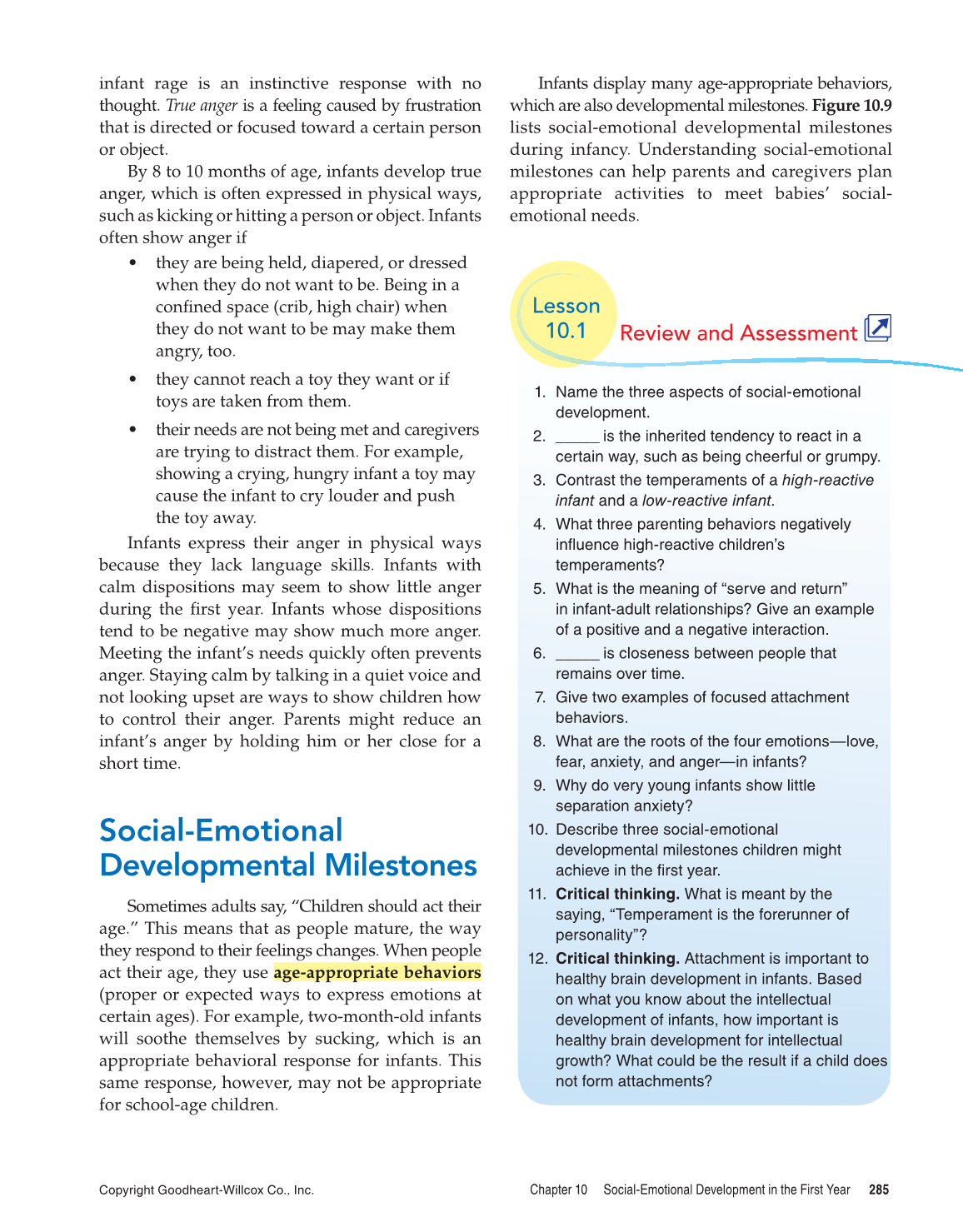Copyright Goodheart-Willcox Co., Inc.
Chapter 10 Social-Emotional Development in the First Year 285
Infants display many age-appropriate behaviors,
which are also developmental milestones. Figure 10.9
lists social-emotional developmental milestones
during infancy. Understanding social-emotional
milestones can help parents and caregivers plan
appropriate activities to meet babies’ social-
emotional needs.
Lesson
10.1
Review and Assessment
1. Name the three aspects of social-emotional
development.
2. _____ is the inherited tendency to react in a
certain way, such as being cheerful or grumpy.
3. Contrast the temperaments of a high-reactive
infant and a low-reactive infant.
4. What three parenting behaviors negatively
influence high-reactive children’s
temperaments?
5. What is the meaning of “serve and return”
in infant-adult relationships? Give an example
of a positive and a negative interaction.
6. _____ is closeness between people that
remains over time.
7. Give two examples of focused attachment
behaviors.
8. What are the roots of the four emotions—love,
fear, anxiety, and anger—in infants?
9. Why do very young infants show little
separation anxiety?
10. Describe three social-emotional
developmental milestones children might
achieve in the first year.
11. Critical thinking. What is meant by the
saying, “Temperament is the forerunner of
personality”?
12. Critical thinking. Attachment is important to
healthy brain development in infants. Based
on what you know about the intellectual
development of infants, how important is
healthy brain development for intellectual
growth? What could be the result if a child does
not form attachments?
infant rage is an instinctive response with no
thought. True anger is a feeling caused by frustration
that is directed or focused toward a certain person
or object.
By 8 to 10 months of age, infants develop true
anger, which is often expressed in physical ways,
such as kicking or hitting a person or object. Infants
often show anger if
• they are being held, diapered, or dressed
when they do not want to be. Being in a
confi ned space (crib, high chair) when
they do not want to be may make them
angry, too.
• they cannot reach a toy they want or if
toys are taken from them.
• their needs are not being met and caregivers
are trying to distract them. For example,
showing a crying, hungry infant a toy may
cause the infant to cry louder and push
the toy away.
Infants express their anger in physical ways
because they lack language skills. Infants with
calm dispositions may seem to show little anger
during the fi rst year. Infants whose dispositions
tend to be negative may show much more anger.
Meeting the infant’s needs quickly often prevents
anger. Staying calm by talking in a quiet voice and
not looking upset are ways to show children how
to control their anger. Parents might reduce an
infant’s anger by holding him or her close for a
short time.
Social-Emotional
Developmental Milestones
Sometimes adults say, “Children should act their
age.” This means that as people mature, the way
they respond to their feelings changes. When people
act their age, they use age-appropriate behaviors
(proper or expected ways to express emotions at
certain ages). For example, two-month-old infants
will soothe themselves by sucking, which is an
appropriate behavioral response for infants. This
same response, however, may not be appropriate
for school-age children.
